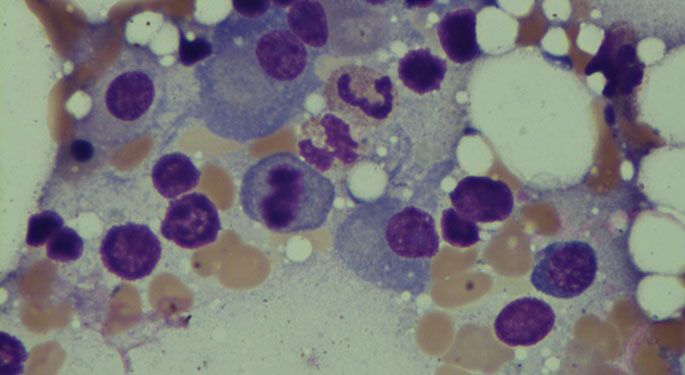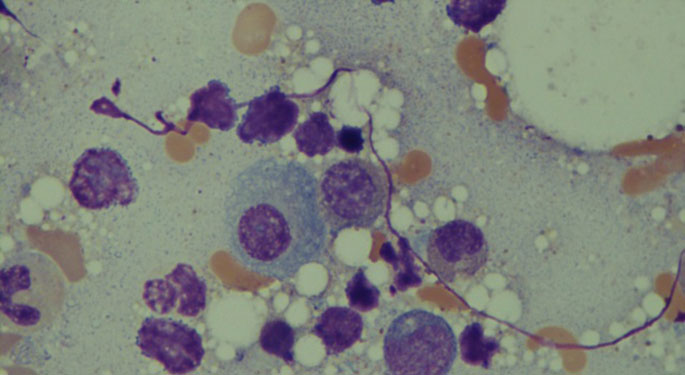What is Multiple Myeloma?

In advanced disease, myeloma cells may comprise a high percentage of the bone marrow.

Myeloma cells are characterized by an enlarged nucleus and a light-colored area adjacent to the nucleus, called a perinuclear halo, and irregular nuclei. Sometimes a myeloma cell may have more than one nucleus.

Stains are used to identify myeloma cells under the microscope. The cytoplasm—the material in the cell excluding the nucleus—appear deep blue.
Multiple myeloma is a cancer of plasma cells, which are a typically located in the bone marrow. The bone marrow is the soft, sponge-like tissue in the center of most bones. Bone marrow produces three types of blood cells: white blood cells, red blood cells, and platelets. Plasma cells develop from B lymphocytes (B cells), a type of white blood cell that is part of the body’s immune system. Plasma cells make antibodies that protect us from infection and toxins.
Multiple myeloma begins when a plasma cell becomes abnormal and divides in an uncontrolled fashion. The abnormal plasma cells are known as myeloma cells. As they multiply, they crowd out normal, healthy cells. Plasma cells typically comprise less than five percent of the cells in the bone marrow. In multiple myeloma the percentage of plasma cells increases to more than 10 percent.
The increased number of abnormal plasma cells can lead to bone destruction and high levels of calcium in the blood (hypercalcemia). The abundance of abnormal plasma cells can also interfere with the functioning of other blood cells, particularly red blood cells that carry oxygen to tissues throughout the body.
Normal plasma cells, as part of the immune system, produce antibodies that fight infections and diseases. Antibodies are a type of protein made by plasma cells, usually in response to an infection or vaccine. Malignant plasma cells, or myeloma cells, produce an abnormal antibody known as M protein (also called monoclonal protein) or a small part of the antibodies called light chains that collects in blood and urine. The M protein does not help fight infection. It can cause the blood to thicken and it can damage the kidneys.
The level of M protein in the blood and urine is measured as an indicator of myeloma activity and response to treatment. It is referred to as an M-spike. In some patients myeloma cells do not produce M protein, in which case the level of disease activity must be assessed differently.
Since myeloma cells typically are found throughout the body, the disease is referred to as multiple myeloma. However, the terms “myeloma” and “multiple myeloma” are often used interchangeably.
Incidence
Multiple myeloma is a relatively uncommon cancer, although it is the second most common blood cancer. The American Cancer Society estimate for new cases in the United States in 2024 is 35,780—19,520 men and 16,260 women. The lifetime risk of getting multiple myeloma is less than one percent—about 1 in 103 men and about 1 in 131 women.
Multiple myeloma is most common in people over the age of 50. Males and African Americans are at increased risk. There are uncommon family clusters of multiple myeloma, suggesting that some risk factors may be inherited, but these factors have not been identified yet.
Conditions that can progress to myeloma include monoclonal gammopathy of undetermined significance (MGUS) and smoldering multiple myeloma (SMM). We monitor patients with these conditions on a regular basis so that intervention can be started if needed.
